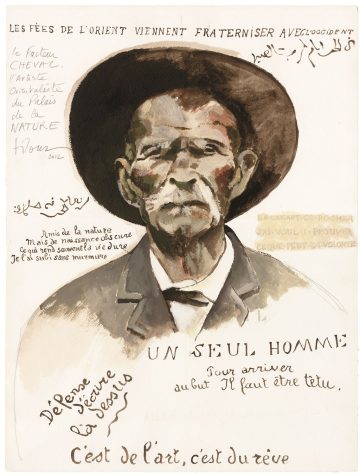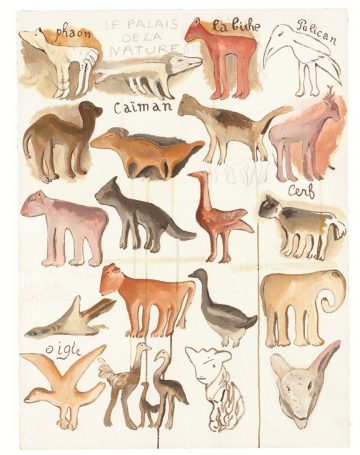Titouan LAMAZOU 1955
Born Antoine Lamazou in 1955 in Casablanca (Morocco), this artist and sailor officially took the name Titouan Lamazou in 1986. A student at the Ecole des Beaux-Arts de Marseille between 1971 and 1974, then at the Ecole des Beaux-Arts d’Aix en Provence, his work is inspired by his travels around the world. From these different adventures, Titouan Lamazou brings back drawings, sketches, notes, gouaches, collages or photographs, and invites the spectator to share his encounters. His creative process is directly linked to his way of life and depicts a subjective state of the world. Since 1998, he has undertaken the project of a travelling artistic residence on board his “Bateau-Atelier”. He has also made numerous portraits of women between 2001 and 2007, and his commitment to the cause of women earned him the nomination as “UNESCO Artist for Peace” in 2013.
In 1998, he exhibited his work for the first time in the exhibition Composition de voyages at the Musée des arts décoratifs in Paris. In 2018, the Musée du Quai Branly gave him carte blanche for the exhibition Le Bateau-Atelier de Titouan Lamazou, prefiguring the stopovers of his itinerant residency in the Polynesian archipelagos. His last exhibition, Titouan Lamazou, fraternal adventurer of the arts and the world’s Elsewhere, dates from 2019 at the Baron Martin Museum in Gray.
Hommage au Facteur Cheval 2012
The eight portraits are watercolours, representing Postman Cheval at different ages, created for the centenary of the Ideal Palace. On one of them is a portrait of Postman Cheval framed by handwriting. In a shade of brown, the delicate brushstrokes depict a postman aged by hard work. Among the many writings, it is possible to read: “THE FAYS OF THE EAST COME TO FRATERNISE WITH THE WEST”, a quotation inscribed in the gallery of the Palace. This is followed by Titouan Lamazou’s commentary “Le Facteur Cheval, l’artiste Orientaliste du Palais de la NATURE” written above the artist’s signature, two writings which underline the interest of the postman in these Arab civilisations. Although he was unable to travel, particularly during his military service in Algeria, which he never did, Cheval was nevertheless very inspired by the Maghreb. The colonial era, his readings, but also the postcards he carried during his long walks, certainly influenced him in the construction of his palace. One finds there notably the architecture of an Egyptian temple, and the representation of mummies. As a brother to all cultures, he built a mosque on the west side of his monument. In 1905, an Egyptian visitor wrote in Arabic script in the postman’s visitors’ book: “Some claim that pain is in love, whereas in love there are days more bitter than patience (desert flower). The architect will inscribe this sentence at the feet of the Three Giants of his palace. An Arabic calligraphy that we can also admire thanks to the transcription that Titouan Lamazou made on this work.


